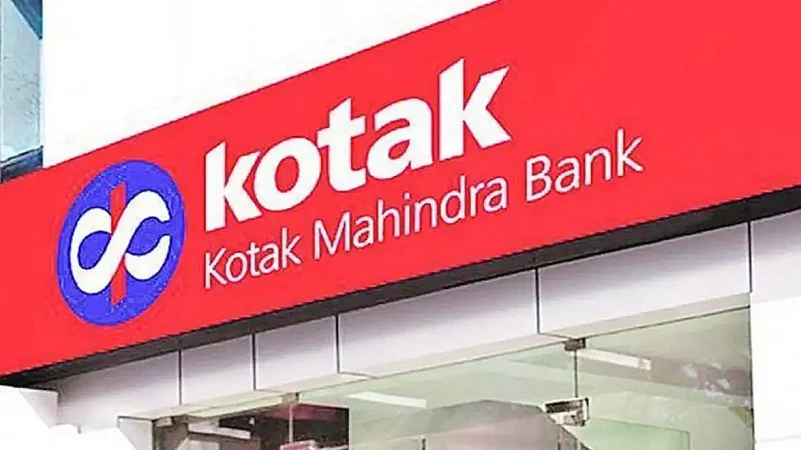Kotak Mahindra Bank, known for its conservative approach towards unsecured lending, seems to have shed the tag with this segment constituting 35.2 per cent of its Q1 loan book, growing 81 per cent year-on-year.
The Mumbai-headquartered bank on Saturday reported a 26 per cent rise in net income at Rs 2,071 crore in the June quarter, buoyed by record margins and a steep fall in dud loans, cushioning the Rs 8,500-crore treasury hit.
Overall, the bank reported a 29 per cent on-year growth in advances during the reporting quarter at Rs 2,80,171 crore, from Rs 2,17,447 crore a year ago, and 3 per cent growth over the March 2022 quarter numbers when its loan book stood at Rs 2,71,254 crore. But as much as 35.2 per cent of this incremental advances are in the unsecured segment, which on annualised basis soared by 81 per cent to Rs 22,085 crore in Q1.
But what is interesting is that it has near zero bad loans in this segment, as given the 90-day margin for default, the bank regularly writes off any stressed account. Even otherwise, it had just 0.62 per cent of net bad loans in the quarter from 1.28 per cent, and gross NPAs (Non-Performing Assests) dipped to 2.24 per cent from 3.56 per cent.
What is more important is that of the incremental Rs 62,724 crore loan sales in the quarter, as much as Rs 22,085 crore are unsecured loans or lending without collaterals. From an overall asset base perspective this is 7.9 per cent of the total outstanding for the fourth largest lender, which was only 5.6 per cent a year ago.
Unsecured loans include credit card outstanding, personal and business loans and also retail microfinance loans or any other advances sans collateral.
On a 12-month comparison, the unsecured book was only 5.6 per cent in June 2021 at Rs 12,221 crore, which means that this book grew at a much faster rate of 81 per cent in June 2022 and now constitutes as much as 35.2 per cent of the incremental loan sales in the quarter.
The main drivers of this faster growth are personal and business loans and consumer durables funding along with credit cards.
While personal and business loans along with consumer durables grew to Rs 11,616 crore from Rs 6,561 crore, and from Rs 10,071 crore in March 2022, up 15 per cent, credit card outstanding grew to Rs 6,819 crore from Rs 3,848 crore annualised and from Rs 5,572 crore in March 2022, up 22 per cent, according to the earnings statement.
In fact, retail microfinance grew the fastest, growing at 101 per cent in the quarter to Rs 3,650 crore from Rs 1,812 crore annualised and from Rs 3,060 crore in Q4 FY22, logging in 19 per cent growth.
Explaining the rationale for the refocus, Dipak Gupta, joint managing director, told PTI on Sunday that the bank's unsecured books faced headwinds three years ago, but then this portfolio was about 7.5 per cent of the total assets.
Since then, the bank has been steadily bringing down this portfolio during the pandemic years when the stress increased and it went down to 5.6 per cent in Q1 FY22.
So, going back to 7.9 per cent now is "effectively reaching the pre-stress level only and I will be comfortable if it scales to 15 per cent or so. Even at that level, ours will still be amongst the lowest unsecured assets", Gupta said.
Asked whether at this rate the unsecured book will touch 10 per cent of the total assets by March 2023, he said may not be, but most likely by June next.
But he was quick to point out that the pandemic has been good in the sense that "it has taught us some good lessons".
"While we happily let around 10 per cent of our customers go after they defaulted, what we have today all good customers.
"Secondly, in the past two years, we have been using a lot of data analytic to assess who is and will be a good customer and based on those data from last September-October we began to get aggressive and corporate loans will still not in demand.
Thirdly, the overall lending atmosphere is also conducive to take some risks. After all, the unsecured lending also gets us better margins, so our risk adjusted returns model is paying us off."
Despite this, he said, the bank has zero delinquencies in unsecured book as "whenever there is stress we write off those books", a good portion of which will be later recovered either through recoveries or through settlements.
However, Gupta admitted that this 80 per cent growth is not sustainable and he'll be happy with a 25-30 per cent growth and expects the retail book to be in mid-teens because "we are still very conscious of taking aggressive risks and at the same time we aren't also wedded to any segment".
Currently, the bank's largest growth driver is home loans and loan against properties which grew 6 per cent sequentially to Rs 80,975 crore from Rs 76,077 crore and 46 per cent annually from Rs 55,623 crore. The wholesale book or corporate loans in fact marginally declined to Rs 66,633 crore sequentially from Rs 60,674 crore and grew 11 per cent on-year from Rs 60,157 crore.
Though home loan is a low-margin business, "we will continue to focus on this given our low-cost funds as we have the highest CASA of 58.2 per cent in the industry and long-term stickiness of the customers", Gupta said.
























.jpg?w=200&auto=format%2Ccompress&fit=max)





